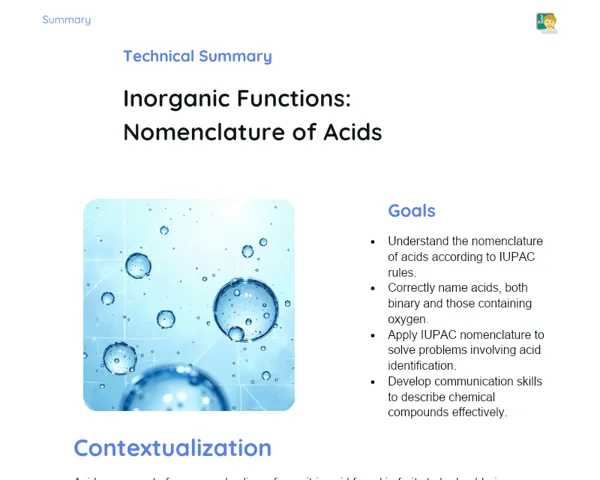Summary Tradisional | Colloids
Contextualization
Colloids are heterogeneous mixtures in which tiny particles of one substance are spread throughout another without fully dissolving. The particles in a colloid are smaller than those in a suspension but larger than those in a solution. These particles are small enough to remain suspended without settling, aided by Brownian motion and electrostatic repulsion. Colloids play a role in many aspects of our daily lives and have significant applications across diverse fields, including food, cosmetics, medicine, and industry.
A familiar example of a colloid is milk, which is a combination of water, fat, and proteins that, while appearing uniform to the eye, is actually a colloid. Another example would be clouds, which are made up of tiny water droplets or ice crystals suspended in the air. Such examples underline how integral colloids are to our everyday experiences. Furthermore, understanding colloids is essential for enhancing products across various industries, ensuring that they meet quality and efficiency standards.
To Remember!
What are Colloids
Colloids are heterogeneous mixtures where particles of one substance (known as the dispersed phase) are spread out in another (known as the dispersing medium). The particles in colloids are of intermediate size between true solutions and suspensions. In true solutions, particles are single atoms or molecules that fully dissolve in the dispersing medium, while in suspensions, the particles are large enough to settle over time.
In colloids, the dispersed particles are small enough to remain suspended, thanks to Brownian motion and electrostatic forces. Brownian motion is the erratic movement of colloidal particles, caused by their collisions with molecules in the surrounding medium. Electrostatic forces help maintain dispersion by giving the particles electric charges that repel one another.
Colloids can be found in numerous products we encounter daily. For example, milk is a colloid with fat droplets distributed in water, and clouds consist of tiny water droplets or ice crystals suspended in the air.
-
Colloids are heterogeneous mixtures with intermediate-sized particles.
-
Colloidal particles remain suspended because of Brownian motion and electrostatic forces.
-
Colloids are present in many everyday products such as food and cosmetics.
Classification of Colloids
Colloids can be categorized into various types based on the nature of the dispersed phase and the dispersing medium. The key classifications include sol, gel, aerosol, and emulsion. A sol is a colloid where solid particles are suspended in a liquid, with examples including paints and blood. A gel, on the other hand, is a semi-solid system where the dispersed particles create a three-dimensional framework; examples include gelatin and hair gel.
Aerosols are colloids where solid or liquid particles are spread in a gas, with common examples being hair sprays and mist. Emulsions are colloids where liquid particles are suspended in another liquid, like mayonnaise and milk. The stability of emulsions often requires emulsifying agents to keep the liquid particles well dispersed.
Understanding the classification of colloids is crucial as it aids in grasping their properties and uses. Each type of colloid has specific traits that relate to its behavior and application in various contexts; for instance, gels can provide thickening properties, and the uniform dispersion in emulsions is vital for the quality and stability of many food and cosmetic products.
-
Colloids can be classified as sol, gel, aerosol, and emulsion.
-
Classification is based on the dispersed phase and the dispersing medium.
-
Each type of colloid has unique properties and applications.
Tyndall Effect
The Tyndall effect is an optical phenomenon that occurs when light is scattered by colloidal particles, which makes the light beam distinguishable as it passes through. Named after the physicist John Tyndall who studied it in the 19th century, this effect distinguishes colloids from true solutions, as particles in true solutions are too diminutive to scatter light, thus rendering the beam invisible.
To see the Tyndall effect in action, one can use a laser pointer. When the laser beam is directed through a colloid like milk, it becomes visible due to the scattering of light by the colloidal particles. In contrast, passing the laser through a true solution, such as saltwater, does not reveal the light beam.
Not only is the Tyndall effect useful for identifying colloids, but it also has practical applications. For instance, it is employed in the production of optical devices and in assessing atmospheric pollutants, where light scattering indicates the presence of colloidal particles in the air.
-
The Tyndall effect refers to the scattering of light by colloidal particles.
-
It allows for the distinction between colloids and true solutions.
-
This effect is applied in practical contexts, such as monitoring atmospheric pollutants.
Properties of Colloids
Colloids showcase various properties that impact their behavior and applications. One significant property is Brownian motion, which is the erratic movement of colloidal particles due to collisions with surrounding molecules in the dispersing medium. This motion assists in keeping particles dispersed and prevents settling.
Another crucial property is the electric charge of colloidal particles. These particles can gain electric charges that repel each other, maintaining the colloid’s stability. This charge may be due to the absorption of ions or the splitting of functional groups on the particle surface. Colloidal stability refers to the particles’ ability to remain dispersed without clumping together, influenced by factors like the electric charge of the particles and the presence of stabilizers.
Colloids also exhibit optical properties, including the Tyndall effect. The scattering of light through colloidal particles assists in identifying colloids and has practical implications. Additionally, colloids are utilized in various domains such as food, cosmetics, medicine, and industry due to their distinctive properties. A sound understanding of these properties is vital for developing and refining colloidal products.
-
Brownian motion keeps colloidal particles dispersed.
-
The electric charge of particles enhances colloidal stability.
-
Optical properties like the Tyndall effect are crucial characteristics of colloids.
Applications of Colloids
Colloids find numerous practical applications thanks to their distinctive properties in various fields. In the food industry, they enhance the texture and stability of products. For instance, mayonnaise is an emulsion in which oil droplets are suspended in water, stabilized by emulsifiers. Ice creams and sauces also use colloids to achieve a smooth, creamy texture.
In cosmetics, colloids aid in formulating creams, lotions, and gels, allowing for a uniform dispersion of active ingredients that improves efficacy and feel upon application. Moreover, colloids play a pivotal role in medicine; suspensions and emulsions enable the administration of substances that do not dissolve readily in water.
In the industrial sector, colloids are key components in products like paints, adhesives, and lubricants. The colloidal characteristics ensure that pigments in paints remain uniformly dispersed, and adhesives leverage colloids to form strong films. The stability of colloids is also critical for the durability and performance of these products.
-
Colloids enhance texture and stability in food products.
-
They are utilized in cosmetics for the even distribution of active ingredients.
-
Colloids are vital in industrial applications, including paints, adhesives, and lubricants.
Key Terms
-
Colloids: Heterogeneous mixtures with intermediate-sized dispersed particles.
-
True solutions: Homogeneous mixtures where particles fully dissolve.
-
Suspensions: Heterogeneous mixtures where particles are substantial enough to settle.
-
Brownian motion: Random movement of colloidal particles caused by collisions with medium molecules.
-
Tyndall effect: Scattering of light by colloidal particles, rendering the beam visible.
-
Colloidal stability: Capability of dispersed colloidal particles to remain apart without clumping.
-
Emulsion: Colloid in which liquid particles are distributed in another liquid.
-
Gel: Semi-solid colloid in which dispersed particles form a three-dimensional matrix.
-
Sol: Colloid in which solid particles are distributed within a liquid.
-
Aerosol: Colloid in which solid or liquid particles are dispersed within a gas.
Important Conclusions
Colloids are heterogeneous mixtures characterized by dispersed particles of intermediate sizes that lie between true solutions and suspensions. These particles remain suspended due to Brownian motion and electrostatic forces. Colloids are prevalent in countless daily products and play a crucial role in industries such as food, cosmetics, and medicine.
Classifying colloids into types like sol, gel, aerosol, and emulsion is essential for understanding their properties and uses. The Tyndall effect, resulting from light scattering by colloidal particles, enables us to identify colloids, helping in various practical assessments. The unique properties of colloids, including Brownian motion and colloidal stability, significantly influence their behavior and applications in diverse settings.
The knowledge acquired about colloids is not only pertinent but also enriches our understanding of numerous phenomena and products that we encounter in our daily lives. This comprehension can facilitate the enhancement of existing products and foster the development of new ones, while providing a strong foundation for further studies in chemistry and related disciplines. We encourage students to delve deeper into the subject and apply this knowledge practically.
Study Tips
-
Revise the concepts of colloids, true solutions, and suspensions by comparing their characteristics and examples.
-
Investigate the practical applications of colloids across different fields like food, cosmetics, and medicine to grasp their significance.
-
Utilize videos and hands-on experiments, such as observing the Tyndall effect with a laser pointer and a colloid, to visualize and reinforce the learned concepts.



